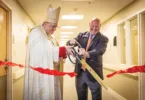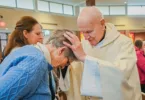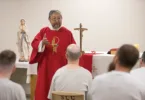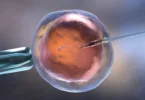
by Karen Mikols Bonar
Special to The Leaven
PILSEN — The church bells of St. John Nepomucene Church here tolled solemnly. Slowly, the motorcade drove north toward the church, and with it, the hearse bearing the remains of one of the community’s most widely known residents, Servant of God Father Emil Kapaun.
Each side of the road was adorned with more than 200 flags, which all flapped crisply in the eastern wind. Past the fields and farmland of his childhood went the motorcade. Past the peaks and valleys. Past the rust-colored sea of milo. Past the beans, which were just beginning their transition from green to gold. And, even, past the occasional wilting sunflower along the shoulder of Remington Road.

Born on April 20, 1916, in rural Pilsen, the childhood of Father Kapaun revolved around the Catholic faith, which was prevalent in this rural Kansas Bohemian community.
His death in a North Korean prison camp was worlds away on May 23, 1951, but his story lives on in the hearts and memories of those in his hometown.
Baby Emil was baptized within the walls of the new church, which was dedicated on Sept. 18, 1915. He celebrated his first confession and received his first Communion in the sanctuary. He would receive confirmation within its walls. Shortly after he was ordained a priest for the Diocese of Wichita in 1940, he celebrated his first Mass as a priest with a crowd of 1,200 witnesses.

The community watched him grow up. The church was his first assignment after he was ordained. It also waited more than 70 years for its native son, who died in a North Korean POW camp, to return home.
And although it would not be his final resting place, it was the first stop.
“He had to come home first,” said his nephew, Ray Kapaun, with moist eyes.
Father Kapaun, a chaplain in the 8th Calvary Regiment of the U.S. Army, was captured on Nov. 2, 1950. It was rumored he was buried in a mass grave in North Korea, with few expectations that his remains would be returned.

Still unidentified, however, the remains were among those transferred to the U.S. as part of the 1953 Korean Armistice Agreement. And on March 4 of this year, it was announced that his remains were positively identified by the Defense POW/MIA Accounting Agency.
For many years, Father Kapaun was buried among 867 remains in the VA’s National Memorial Cemetery of the Pacific in Hawaii. His resting place was under a headstone that read “US Unknown” in the shade of two plumeria trees.
“We didn’t expect it at all,” said lifelong Pilsen parishioner Dr. Eugene Vinduska. “It was a lot of years from the time he was captured.”
Vinduska, who is 90, was an altar server during Father Kapaun’s time as a priest at the parish. He was also one of 10 parish children selected to be in the procession for the newly ordained priest’s first Mass.
His eyes shimmered as he spoke of his most memorable Mass experience.
“I was kneeling on the step and consecration comes. When Father Kapaun elevated the host, his hands trembled,” Vinduska said. “I felt like something happened, and it was really God in that host. It strengthened my faith.”
•••
From Sept. 25-27, the priest’s flag-draped coffin remained in the church. Around the physical remains, the parish community came together, first throughout the night in eucharistic adoration. Then, on Sept. 26, Priesthood Sunday, the community celebrated one final Mass with Father Kapaun.
His chalice sat on the altar and bore the precious blood of Christ during the consecration. The parish was again, sacramentally, united with its beloved priest.
“[Father Kapaun] would hear deep within his soul a desire to be a priest for a specific group of Christ’s sheep, those in the armed forces,” said Bishop Carl Kemme in his homily. “It was his priesthood that was the foundation of his service to the soldiers he supported. He was Chaplain Father Kapaun and, as a priest, he became a spiritual father to those men in a way that changed their lives.”

Following the Mass, a parish picnic-like atmosphere prevailed, as parishioners gathered in the church basement to swap memories.
Paulette Holub, who grew up in Pilsen, said her mother shared stories about the priest. Her uncle, Paul Svitak, was standing at the top of the stairs, and Kapaun was at the bottom and tossed a ball up to his friend.
“[Father Kapaun] threw the ball and said, ‘Paul, catch!’ My uncle missed, and it broke the window [on the church door] and my grandfather had to buy a new window,” she shared with a laugh.
Eighty-five-year-old Robert Klenda now lives in Kimball, Nebraska, but grew up in the parish.
“In those days, he was a parishioner, not a celebrity,” Klenda said. “He was just part of the parish.”
Vinduska agreed.
“There was nothing exciting about us. This is a sleepy little village and he was part of it,” Vinduska said. “He was just as plain as a checkered tablecloth. He didn’t stand out or anything, but he cared for all ages.”
•••
Kelly Krch is a parishioner at the parish, and a docent at Father Kapaun’s Childhood Museum. She grew up in Brown County in northeast Kansas and moved to Pilsen in 1993 after she and her husband wed.
“I think what inspires me most about him is his absolute love,” she said. “He saw no boundaries, no division. When he looked at someone, he saw a child of God. It didn’t matter if they were American, North Korean, South Korean. In our world today, we need examples like that.”

In the spring, when the announcement was made and plans began for Father Kapaun’s homecoming, it felt surreal.
“In March, it felt like a long way off,” Krch said. “It was an entirely different feeling when I saw the hearse come up the road. It all of a sudden was real. I’ve been telling stories about this man for years, but he’s in our church right now.”
•••
The weekend was important for the parish, but not because of Father Kapaun’s decorated military experience, which includes the Medal of Honor, posthumously awarded by the President Barack Obama on April 11, 2013.
“There are still people in this parish that knew him, and definitely knew his mother,” Krch said of Bessie Kapaun, who died in 1986. “Some of the saints were hundreds of years in the making, but [Father Kapaun] is within people’s lifetime.
“This [homecoming] is important because people remember praying for him, for Bessie and Enos (his parents). [Father Kapaun] was their community member. . . . It was right that he would come back here; the circle of his life now feels complete.”
The ripples of Father Kapaun’s homecoming extend beyond the immediate parish. Terry Klenda, who works for Centre USD 397 in Lost Springs, said many staff members are Catholic. Because of the interest in Father Kapaun’s homecoming events, the school board permitted the schools to close on Sept. 29 so community members could attend the funeral.
“I think we needed this time as a parish,” Klenda said. “His mom always prayed that he would be found and come home. For Ray (Kapaun) to insist that he come [to the parish] makes it all the more special. I feel like we do mean something, we’re more than just his hometown.”

Simon Makovec grew up at the parish in Pilsen and is now a parishioner at St. Bernard in Wamego. He made a fast trip to Marion County on Sept. 27.
“It was a huge honor to not only be able to come back for this, but to be asked to be a pallbearer,” said Makovec, a member of the Army National Guard who served a 15-month tour in Iraq from 2006-07.
During his military service, which spanned from 2001-07, he said his devotion to his hometown priest deepened.
“I prayed to Father Kapaun on a daily basis, especially every time we went out on patrol,” he said. “I know he’s the reason I came home.”
•••
The bones of Father Kapaun departed Pilsen on Sept. 27. The hearse bearing his body drove east through the parish cemetery, and stopped so Ray Kapaun could visit the graves of his grandparents, Bessie and Enos.
“It was a very tough decision to decide where he would go,” Kapaun said. “Leaving today is going to be hard for me. I can’t imagine how hard it’s going to be for the [parish community]. It will be tough pulling out of the parking lot with him.”
Father Kapaun’s remains are interred inside the Cathedral of the Immaculate Conception in Wichita, and the tomb is open to visitors (see below for details).
“It’s breaking my heart,” Kapaun said, tearing up. “But to know he’ll be in Wichita where a lot of people will be able to see him and be able to pray to him is a comfort. I truly believe people will want to come out here, where he grew up, the church where he was a priest, to visit and learn more about my uncle.”

Those who knew him, though, were grateful for the weekend — and the chance to say goodbye.
“I came because I wanted him to know that I remember him,” Vinduska said in a tight voice.
He also came with a simple request.
“I want him to pray for me,” Vinduska said. “I said, ‘I know you’re pretty busy, but maybe you could remember the little kids who served with you so many times.’”
Learn more about Father Kapaun
Father Kapaun’s Childhood Museum is located at St. John Nepomucene Church, Pilsen.
Hours: Tuesday, Friday, 1-4 p.m.*
Contact Rose Davidson in advance at Holy Family Parish office by email at: hfpmarion@yahoo.com.
* Other times are available, but advance reservation is required.
St. John Nepomucene Church, Pilsen, is open daily from 6 a.m. to 10 p.m. Mass is celebrated at 8 a.m. on Thursday and 10:30 a.m. on Sunday.
Visit the tomb
Father Kapaun’s Tomb is located at the Cathedral of the Immaculate Conception, 430 N. Broadway St., Wichita.
The tomb will be available for visitors beginning Nov. 1. For groups with more than 10, advance reservations are required.
Group visiting hours:
Monday: 1-8 p.m.
Tuesday: 1-8 p.m.
Wednesday: CLOSED
Thursday: 1-6 p.m.
Friday: 1-4:30 p.m.
Saturday: 8-10:30 a.m.
Sunday: 2-8 p.m.
Private visiting hours (families or groups of less than 10):
Monday: 9-11:30 a.m.; 1-8 p.m.
Tuesday: 9-11:30 a.m.; 1-8 p.m.
Wednesday: CLOSED
Thursday: 9-11:30 a.m.; 1-6 p.m.
Friday: 9-11:30 a.m.; 1-4:30 p.m.
Saturday: 8-10:30 a.m.; 4-5 p.m.
Sunday: 2-8 p.m.
Visit online at: frkapaun.org/visit-us/.
Timeline of Father Kapaun’s life
April 20, 1916 — Emil Joseph Kapaun is born on Holy Thursday to Bessie (Hajek) and Enos Kapaun in the couple’s remote farmhouse.
May 9, 1916 — Emil is baptized at St. John Nepomucene Church in Pilsen.
1930 — Emil enters Conception Seminary in Conception, Missouri.
1936 — Begins theological studies at Kenrick Seminary in St. Louis.
June 9, 1940 — Emil is ordained a priest for the Diocese of Wichita.
November 1943 — Father Kapaun is appointed pastor of St. John Nepomucene in Pilsen.
July 12, 1944 — Father Kapaun enters the U.S. Army Chaplain Corps.
March 1945 — Father Kapaun is deployed to Burma (Myanmar) and India.
Jan. 3, 1946 — He is promoted to the rank of captain by the U.S. Army.
May 1946 — He returns from deployment.
1946-48 — Father Kapaun attends The Catholic University of America in Washington, D.C., and earns a master’s in education.
1948 — He is granted permission to return to chaplaincy, rejoins the Army, and is assigned to the Anti-Aircraft Artillery Corps.
Dec. 12-16, 1949 — Father Kapaun makes his final visit to Pilsen.
July 11, 1950 — The 8th Cavalry Regiment, 1st Cavalry Division, where Father Kapaun served as chaplain, is deployed to South Korea.
Aug. 2, 1950 — Father Kapaun rescues a wounded soldier amid a barrage of machine-gun fire near Kumchon, South Korea, and receives the Bronze Star Medal for bravery in action.
Nov. 2, 1950 — Father Kapaun and soldiers he was with are captured by the Communists.
March 1951 — Father Kapaun leads an Easter service for his fellow prisoners, despite having been forbidden to do so.
April 1951 — In addition to a blood clot forming in his leg, Father Kapaun contracts pneumonia.
May 1951 — Chinese guards realize Father Kapaun is beginning to recover and move him to the camp “hospital,” where prisoners were taken to die. As he departed, Father Kapaun asked forgiveness of the guards and gave them a blessing.
May 23, 1951 — Father Kapaun dies in the “death house” from malnutrition and starvation. He was 35 years old.
August 1951 — Chaplain Kapaun is awarded the Distinguished Service Cross.
1993 — The Archdiocese for the Military Services opens the cause for Father Kapaun’s canonization, and he is given the title Servant of God.
2008 — His cause for canonization is transferred to the Diocese of Wichita.
November 2015 — Bishop Carl Kemme presents a summary of the documentation of Father Kapaun’s life to the Congregation for Saints’ Causes in Rome.
April 11, 2013 — The Medal of Honor is posthumously awarded to Chaplain Kapaun by President Barack Obama for his actions during the Battle of Unsan. It is the highest award given to members of the military. Only five chaplains have received the honor since the Civil War; all were Catholic priests.
July 2021 — The government of South Korea inducts Father Kapaun into the Order of Military Merit and bestows upon him its highest military award, the Taegeuk Service Medal.
March 4, 2021 — It is announced that the remains of Father Kapaun have been identified.
Karen Mikols Bonar is a freelance writer and photographer based in Salina. She is a graduate of Kapaun Mt. Carmel High School in Wichita.







Emotional reading about this incredible man of God. I know that he has put faith in me again where I had none. I asked a priest where I live if I was awful because I feel as though my faith has been tested but this man Emil this servant of God has put that faith in me forever. I find myself praying with him he has a birthday 3 days from mine and my whole life plumeria has been a peaceful scent for me I thought it was interesting that he was in Hawaii between two of the same trees. I have been telling everyone about Father Emil my grandfather was in Korea and he never spoke a word of it but maybe they crossed paths. God bless those who identified him and brought him home as well.